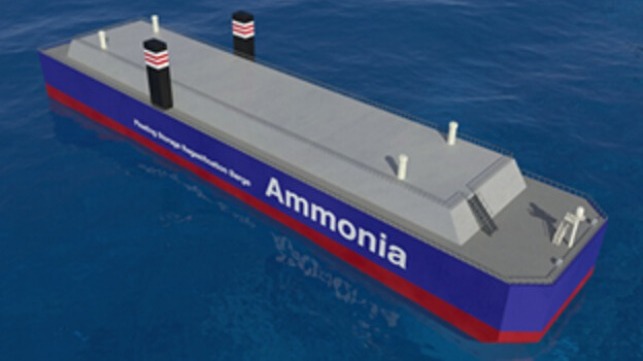Ammonia FSRB Receives Design Approval Supporting Fuel Transition Plan

A Japanese project applying the principles for floating storage and regasification to ammonia continues to make progress completing its initial risk and design studies. The Japanese classification society ClassNK awarded Approval in Principle for the design at the end of December 2022.
The R&D effort was announced last summer as part of Japan’s aggressive efforts for the adoption of ammonia as an alternative energy source. The Ministry of Economy, Trade and Industry (METI) has mapped out a plan to add 30 million tonnes per year of renewable ammonia to the country's fuel mix by 2050, intending to reduce emissions from legacy power plants and Japanese shipping.
Nippon Yusen Co. (NYK), Nippon Shipyard Co., and IHI Co. are leading the efforts to develop the ammonia FSRB. They point to the challenges such as securing land for new onshore facilities (storage tanks and regasification facilities) as well as the size of the initial investment that will be required to supply ammonia as a fuel for the existing thermal power plants which today in Japan mostly use coal. Compared to building an ammonia storage base on land, they believe the ammonia FSRB can be introduced at a lower cost and in a shorter period of time. Utilizing the A-FSRB as an alternative to onshore facilities they expect will contribute to the early and stable supply of ammonia fuel.
They highlight that to achieve the AiP for this project they were required to undertake an extensive risk identification study. At present, there are no international treaties or regulations regarding floating storage regasification equipment when ammonia is used as cargo. The three companies and Nippon Kaiji Kyokai (ClassNK) identified comprehensive risks for various contingencies and worked to identify technical issues from the initial study stage. When identifying risks, they used a gap analysis method to identify differences between conventional ships and floating structures such as for heavy oil or LNG, and assess their impact.
The result of this phase of the project is a future technical study for possible accidents and differences between conventional ships and floating structures. This permitted them to receive the world’s first AiP for an A-FSRB which handles ammonia as cargo.
The companies report that they are continuing to consider the arrangement and introduction of the system with potential early adopters of the system as well as legal and regulatory compliance. Among the early adopters, they highlight the potential with electric power companies providing the fuel source to convert from coal to ammonia. METI is aiming to substitute 20 percent of the coal supply for Japan's coal-fired power stations with ammonia by 2030 and increasing it over time to at least 50 percent.
NYK and its parts are also conducting an economic evaluation to support the development of the A-FSRB. NYK is leading the project and developing the base design, while Nippon Shipyard is studying the hull form and equipment requirements. IHI is focusing on ammonia handling and the vaporization process.
